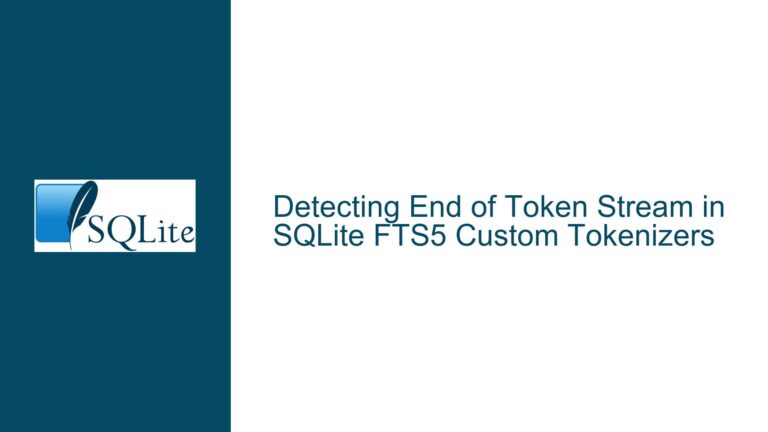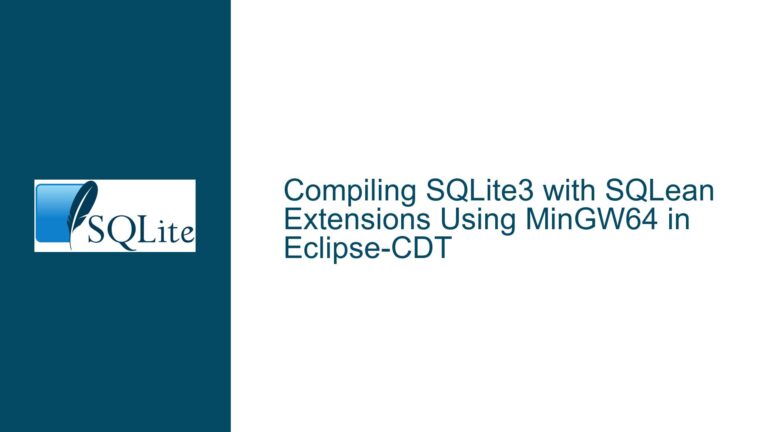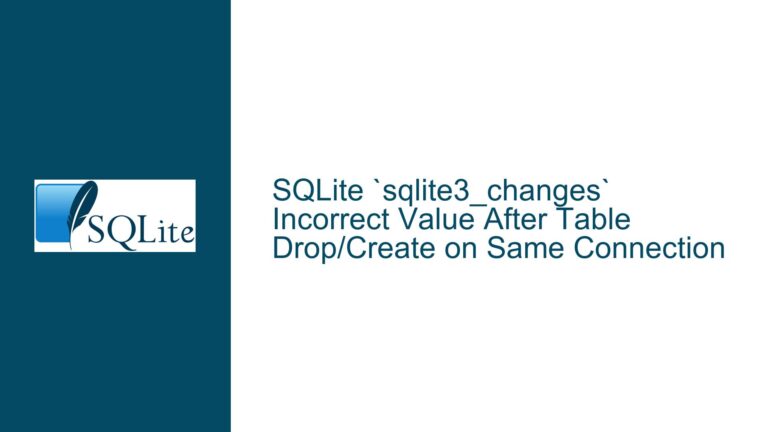Feasibility and Implementation of an Asynchronous API for SQLite LSM Extension
Feasibility of Asynchronous API for SQLite LSM Extension
The concept of an asynchronous API for the SQLite LSM (Log-Structured Merge-Tree) extension is a topic that warrants a detailed exploration, especially when considering the standalone use of the LSM extension. The LSM extension is designed to provide a high-performance storage engine for SQLite, leveraging the benefits of log-structured merge-trees to optimize write-heavy workloads. However, the question of whether an asynchronous API can be effectively implemented for this extension requires a deep dive into the architecture of both SQLite and the LSM extension, as well as the inherent challenges of asynchronous operations in database systems.
SQLite, by design, is a synchronous database engine. This means that operations are executed in a sequential manner, with each operation waiting for the previous one to complete before proceeding. This design choice simplifies the internal architecture of SQLite, making it easier to maintain and ensuring data consistency. However, it also means that SQLite may not fully leverage the potential performance benefits that asynchronous operations can offer, particularly in scenarios where high concurrency and low latency are critical.
The LSM extension, on the other hand, is optimized for write-heavy workloads, where data is continuously appended to the database. The LSM tree structure allows for efficient handling of large volumes of writes by batching them together and merging them in the background. This design inherently lends itself to a certain degree of asynchrony, as the merging process can be performed independently of the write operations. However, the current implementation of the LSM extension does not provide a fully asynchronous API, which limits its ability to fully exploit the potential performance benefits of asynchronous operations.
The feasibility of implementing an asynchronous API for the LSM extension depends on several factors, including the complexity of the underlying data structures, the need for thread safety, and the potential impact on data consistency. Asynchronous operations introduce additional complexity, as they require careful management of concurrent access to shared resources, as well as mechanisms to ensure that data remains consistent in the face of concurrent modifications. Additionally, the LSM extension must be able to handle the potential for out-of-order execution of operations, which can occur in an asynchronous environment.
Challenges of Asynchronous Operations in LSM Extension
The primary challenge in implementing an asynchronous API for the LSM extension lies in the need to maintain data consistency while allowing for concurrent access to the database. In a synchronous environment, each operation is executed in sequence, ensuring that the database remains in a consistent state at all times. However, in an asynchronous environment, multiple operations may be executed concurrently, leading to potential conflicts and inconsistencies.
One of the key challenges is ensuring that the LSM tree remains in a consistent state despite concurrent modifications. The LSM tree is a complex data structure that relies on a series of levels, each containing a set of sorted runs. As data is written to the database, it is first appended to an in-memory structure (the memtable) and then flushed to disk as a sorted run. These runs are periodically merged in the background to maintain the efficiency of the tree. In an asynchronous environment, multiple threads may be writing to the memtable simultaneously, leading to potential conflicts when the memtable is flushed to disk.
Another challenge is managing the merging process in an asynchronous environment. The merging of sorted runs is a critical operation in the LSM tree, as it ensures that the tree remains efficient and that queries can be executed quickly. However, merging is a resource-intensive operation that can take a significant amount of time to complete. In an asynchronous environment, the merging process must be carefully coordinated with other operations to ensure that it does not interfere with ongoing writes or reads. This requires the implementation of sophisticated synchronization mechanisms, such as locks or semaphores, to ensure that the merging process does not conflict with other operations.
Additionally, the LSM extension must be able to handle the potential for out-of-order execution of operations. In an asynchronous environment, operations may be executed in a different order than they were submitted, leading to potential inconsistencies in the database. For example, if a write operation is executed after a read operation that depends on it, the read operation may return stale or incorrect data. To address this issue, the LSM extension must implement mechanisms to ensure that operations are executed in the correct order, or that the results of out-of-order operations are properly synchronized.
Implementing Asynchronous API with PRAGMA journal_mode and WAL
One potential approach to implementing an asynchronous API for the LSM extension is to leverage SQLite’s existing support for asynchronous operations through the use of the PRAGMA journal_mode and Write-Ahead Logging (WAL) features. The PRAGMA journal_mode directive allows the database to be configured to use different journaling modes, which can impact the performance and consistency of the database. The WAL mode, in particular, is designed to improve concurrency by allowing multiple readers and writers to access the database simultaneously.
In WAL mode, all changes to the database are first written to a separate WAL file, rather than directly to the main database file. This allows readers to continue accessing the database without being blocked by writers, as the readers can access the database file while the writers are writing to the WAL file. Once the changes are safely written to the WAL file, they are eventually transferred to the main database file in a process known as checkpointing. This approach allows for a high degree of concurrency, as readers and writers can operate independently of each other.
To implement an asynchronous API for the LSM extension, the extension could be modified to take advantage of the WAL mode. Specifically, the LSM extension could be configured to write changes to the WAL file asynchronously, allowing multiple threads to write to the database simultaneously without blocking each other. The LSM extension would then need to implement a mechanism to periodically checkpoint the WAL file, transferring the changes to the main database file in a way that does not interfere with ongoing operations.
However, implementing an asynchronous API in this way would require significant modifications to the LSM extension, as well as careful consideration of the potential impact on data consistency. The LSM extension would need to ensure that changes written to the WAL file are properly synchronized with the main database file, and that the checkpointing process does not introduce inconsistencies. Additionally, the LSM extension would need to handle the potential for out-of-order execution of operations, ensuring that the results of asynchronous operations are properly synchronized with the rest of the database.
Another consideration is the impact of asynchronous operations on the performance of the LSM extension. While asynchronous operations can improve concurrency and reduce latency, they can also introduce additional overhead, particularly in terms of memory usage and CPU utilization. The LSM extension would need to be carefully optimized to ensure that the benefits of asynchronous operations outweigh the costs, and that the extension remains efficient even under high levels of concurrency.
In conclusion, while the implementation of an asynchronous API for the SQLite LSM extension is technically feasible, it presents several significant challenges that must be carefully addressed. The LSM extension would need to be modified to support asynchronous operations, while ensuring that data consistency is maintained and that the performance of the extension is not adversely affected. By leveraging SQLite’s existing support for asynchronous operations through the use of the PRAGMA journal_mode and WAL features, it may be possible to implement an asynchronous API that provides the benefits of improved concurrency and reduced latency, while maintaining the reliability and consistency of the database. However, this would require a significant investment of time and effort, as well as a deep understanding of both the SQLite and LSM extension architectures.






